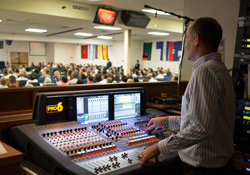
F) Once your voices are mixed, use the console’s sub-groups to set the balance between the music and the vocals. In general, the vocals are set around the same level as the music. What makes the vocals stand out in the mix should be how well you planned and managed the frequency distribution of the band and the vocals. When “EQing” the band’s instruments remember to leave room (frequency wise) for the singers.
G) You should hear a “sound” that is proportional to the size of the choir or vocal group (i.e., if you have a 6-piece choir, it should sound like a 6-piece choir, not like a quartet, a trio or a duet).
Constructing The Mix: FX (Effects)
I have to confess that I’m a big fan of effects, but can’t use them all the time for various reasons. A mix must be artistic, and part of this is refraining from certain things we like and being sensitive to each song—and even to each performance of the same song.
Some songs may require long reverb, while other songs require nothing at all. Reverb and delay can be used subtlety to provide ambience to the vocals. In some particular (and extreme) cases, long delays can be used to create the illusion of a second BGV group repeating a small passage. Be creative and feel free to experiment. Not all songs require the same reverb or delay. As with any piece of gear, know your FX processor(s) and parameters.
Psychoacoustic Phenomena
Perceived balance of vocals and the band—when mixing the same group performing a well-known song (to you) on a regular basis, unconsciously you might tend to put the vocals at a level (relative to the rest of the band) too low, thereby making it hard for the audience to hear them. Now, you may “hear” or perceive the lyrics clearly because you already know them and/or have heard them many times. However, this is not the case for the audience. (I’ve seen this psychoacoustic phenomenon happen with professional shows and tours many times.)
In this business, your ears are your most valuable possession. They are more important than your legs or arms (food for thought). So take good care of your ears by visiting a hearing specialist at least twice a year, and don’t ever introduce anything solid into your ear channel, not even to clean it (even a cotton-tip stick can cause damage to your ear drums).
Every time you hear a sound, your brain tries to decipher what it is and what it means. This indicates that those structures of your brain dedicated to process sound, communication, and speech are constantly working, even when you’re just sitting around the house doing nothing or even sleeping. Particularly when working with audio, this consumes energy and eventually you get tired. Behold, you’ve reached the threshold for hearing fatigue. It happens even at lower sound pressure levels. A good way to prevent this fatigue is by taking regular breaks when exposed to continuous music, say, every 30 minutes or so.
Flu, cold, allergies and congestion affect your perceived sound field and also the frequency response of your ears. Don’t mix a show if you have one of these conditions.
And finally, don’t fly-by-wire: Use your EARS, not your eyes. Be prepared, plan ahead, and take notes. The goal is professionalism and excellence on your part.
Jose David Irizarry has been heavily involved in live sound for almost a decade, mixing Christian music and popular events, and he’s also currently the technical director at his church in Canovanas, Puerto Rico. Reach him at [email protected].
